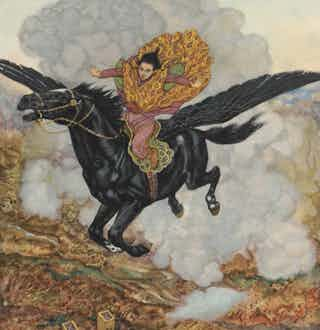
This project, Narrative Constellations, draws from previous work in narratology that proposes to examine the characteristics and structure of tales. This interactive interface allows users to explore figures from the universe of One Thousand and One Nights at the corpus level, taking inspiration from Vladimir Prop's Morphology of the Tale.
One Thousand and One Nights is a collection of tales (the exact number varies depending on the version). To save her life, Scheherazade tells stories each evening to the King, cleverly embedding tales within tales. The different stories in the collection share common characteristics: recurring characters, narrative patterns, places, objects, and more.
The idea for this project came to me while observing my girlfriend sketching in her notebook to summarize each tale one by one for her thesis on One Thousand and One Nights. I conceived an interface that allows users to explore and visualize the richness of these tales with the help of machine learning.
Philosophically, this work raises questions about memory management.
- While the machine processes information exhaustively, humans filter and rank data using selective memory.
- The machine provides a deterministic analysis, while human analysis is subjective and can evolve.
- The machine processes information factually, while humans can interpret.
- The machine can ingest large quantities of information quickly, while humans are bound by time.
~
The interface consists of two parts. The first, on the left, is a node graph where each node represents a recurring figure in the tales. Fisherman, genie, merchant; these are often protagonists whose roles are tied to their function. The central node is the selected figure. All the other nodes linked to it belong to the same tale and have likely interacted in the story. Clicking on a child node makes it the central figure, and the interface updates accordingly.
The second part, on the right, is a timeline composed of all the tales lined up end-to-end. For each tale, the interface indicates whether the selected figure appears in a positive (blue gradient) or negative (red gradient) context. It also shows where the figure appears in the collection: different occurrences are symbolized by lines.
This project was my first experience with natural language processing (NLP) algorithms, which I learned during my studies in machine learning.
If Vladimir Prop had been born in our time, would have been doing machine learning?